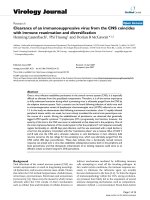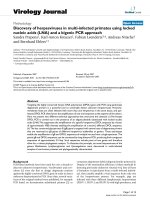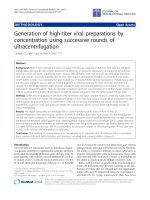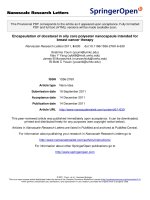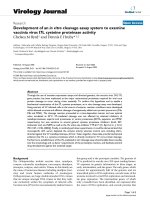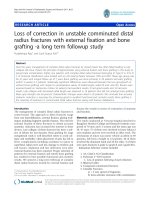Báo cáo sinh học: "Reduction of inbreeding in commercial females by rotational mating with several sire lines" ppsx
Bạn đang xem bản rút gọn của tài liệu. Xem và tải ngay bản đầy đủ của tài liệu tại đây (356.67 KB, 18 trang )
Genet. Sel. Evol. 36 (2004) 509–526 509
c
INRA, EDP Sciences, 2004
DOI: 10.1051/gse:2004014
Original article
Reduction of inbreeding in commercial
females by rotational mating with several
sire lines
Takeshi H
a
,TetsuroN
b
,FumioM
c∗
a
Graduate School of Science and Technology, Kobe University, Kobe, Japan
b
Faculty of Engineering, Kyoto Sangyo University, Kyoto, Japan
c
Faculty of Agriculture, Kobe University, Kobe, Japan
(Received 17 November 2003; accepted 27 April 2004)
Abstract – A mating system to reduce the inbreeding of commercial females in the lower level
was examined theoretically, assuming a hierarchical breed structure, in which favorable genes
are accumulated in the upper level by artificial selection and the achieved genetic progress is
transferred to the lower level through migration of males. The mating system examined was ro-
tational mating with several closed sire lines in the upper level. Using the group coancestry the-
ory, we derived recurrence equations for the inbreeding coefficient of the commercial females.
The asymptotic inbreeding coefficient was also derived. Numerical computations showed that
the critical factor for determining the inbreeding is the number of sire lines, and that the size of
each sire line has a marginal effect. If four or five sire lines were available, rotational mating was
found to be quite an effective system to reduce the short- and long-term inbreeding of the com-
mercial females, irrespective of the effective size of each sire line. Oscillation of the inbreeding
coefficient under rotational mating with initially related sire lines could be minimized by avoid-
ing the consecutive use of highly related lines. Extensions and perspectives of the system are
discussed in relation to practical application.
inbreeding / coancestry / rotational mating / commercial females
1. INTRODUCTION
The control of the increase of inbreeding is a common policy in the main-
tenance of animal populations. To reduce the inbreeding rate in conserved
populations or control lines in selection experiments, many strategies, such
as equalization of family sizes [10, 29], choice of parents to minimize average
coancestry [4, 27] and various systems of group mating [17, 24, 29] have been
proposed.
∗
Corresponding author:
510 T. Honda et al.
In most animal breeds in commercial use, the solution of the inbreeding
problem will be complicated by the hierarchical structure, in which favorable
genes are accumulated in the upper level of the hierarchy by artificial selec-
tion and the achieved genetic progress is transferred to the lower level mainly
through the migration of males [23, 28]. In such a structure, different systems
are required for reducing the inbreeding rate in the breed, according to the
levels of the hierarchy. As shown by many authors [16, 21, 25, 31], selection
is inevitably accompanied by an increase in inbreeding. Thus, the main prob-
lem of inbreeding in the upper level of the hierarchy is to maximize the genetic
progress under a restricted increase of inbreeding, and a large number of selec-
tion and mating systems for this purpose have been developed (e.g. [5,15,26]).
In the present study, we focused on a mating system to reduce the inbreed-
ing rate in commercial females in the lower level of the hierarchy. Farmers in
the lower level of the hierarchy usually rear females to produce commercial
products and their replacements. Since the traits related to commercial pro-
duction and reproduction can show strong inbreeding depression [9, 20], the
suppression of increased inbreeding in the commercial females will be a prac-
tically important issue. We supposed a situation where males are supplied by
several strains (referred to as “sire lines” hereafter) in the upper level of the
hierarchy. One of the most efficient systems will be the rotational use of the
sire lines, as in rotational crossing with several breeds. The use of this mat-
ing system to reduce the inbreeding in commercial females was first proposed
by Nozawa [19]. Using the methodology of path analysis, he worked out the
recurrence equation of the inbreeding coefficient under rotational mating with
full-sib mated sire lines, and showed that this type of mating is quite an effec-
tive system to reduce the long-term inbreeding accumulation in commercial fe-
males [19]. In this study, we derive more general recurrence equations, which
allow the evaluation of the effects of the number and size of sire lines and
the initial relationship among them. Based on numerical computations with
the equations obtained, the practical efficiency of the rotational mating system
was examined.
2. MODELS AND ASSUMPTIONS
2.1. Theory of group coancestry
In the derivation, we applied the group coancestry theory [6, 7], which is
an extension of the coancestry of individuals [14] to groups of individuals.
Under random mating, the group coancestry has the same operational rule
Inbreeding under rotational mating 511
as the ordinary coancestry. For example, consider the group of individuals x
with parental groups of p and q, each of which descended from grandparental
groups of a, b,andc, d, respectively. Letting φ
p·q
be the group coancestry
between two groups p and q, the expected inbreeding coefficient (F
x
)ofindi-
viduals in group x is expressed as:
F
x
= φ
p·q
=
1
4
φ
a·c
+ φ
a·d
+ φ
b·c
+ φ
b·d
. (1)
The group coancestry of group x with itself is defined as the average pairwise
coancestry including reciprocals and self-coancestries [4]. Thus,
φ
x·x
=
1 + F
x
2N
+
N − 1
N
¯
φ
x
, (2)
where N is the number of individuals in group x,and
¯
φ
x
is the average pairwise
coancestry among individuals (excluding self-coancestries).
2.2. Mating scheme and population structure
We suppose a single commercial population of females, maintained by mat-
ing with sires rotationally supplied from n sire lines, each with the same con-
stant size of N
m
males and N
f
females over generations. The sire lines are
assumed to be completely closed to each other after the initiation of rotational
mating, but with various degrees of relationships in the initial generations.
Within each sire line, random mating and discrete generations are assumed.
Thus, the inbreeding coefficient in each sire line at generation t (F
∗
t
)iscom-
puted by the recurrence equation
F
∗
t
= F
∗
t−1
+
1
2N
e
(1 − 2F
∗
t−1
+ F
∗
t−2
), (3)
where N
e
= 4N
m
N
f
/
N
m
+ N
f
is the effective size of the sire line [33].
The line supplying sires to the commercial females in a given generation is
referred to as the supplier at that generation. We give sequential numbers 1,
2, , n to the suppliers in generations 0, 1, , n-1, respectively. Letting
S
t−i
be the sequential number of the supplier in generation t − i, S
t−i
could be
determined by
S
t−i
= MOD
(
t − i, n
)
+ 1,
where MOD
(
x, n
)
is the remainder of x divided by n. Note that, because of
the nature of rotational mating, S
t−i
= S
t−i−kn
for a given integer number k.
512 T. Honda et al.
The groups of males and females in the sire line S
t−i
are denoted by m(S
t−i
)
and f (S
t−i
), respectively. The group coancestries within and between male and
female groups are assumed to be equal in a given generation t − 1:
¯
φ
m(S
t−1
), t−1
=
¯
φ
f (S
t−1
), t−1
= φ
m(S
t−1
)· f (S
t−1
), t−1
= F
∗
t
. (4)
The population of commercial females is denoted by c. Discrete generations
with the same interval as the sire lines and random mating with supplied sires
were assumed in the commercial population.
3. RECURRENCE EQUATION FOR INBREEDING COEFFICIENT
OF COMMERCIAL FEMALES
3.1. Rotational mating with unrelated sire lines
We first consider the case with unrelated sire lines. In this case, it is apparent
that the inbreeding coefficient (F
t
) of the commercial females within the first
cycle of rotation is zero; F
t
= 0fort ≤ n. In Figure 1, the pedigree diagram for
t ≥ n + 1 is illustrated. Applying the operational rule of coancestry (Eq. (1)) to
the diagram, we get an expression of the inbreeding of the commercial females
in generation t ≥ n + 1as
F
t
= φ
m(S
t−1
)·c,t−1
=
1
2
n+1
φ
m(S
t−1
)·m(S
t−1
)
+ φ
f (S
t−1
)·m(S
t−1
)
+ φ
m(S
t−1
)·c
+ φ
f (S
t−1
)·c
t−n−1
. (5)
From (2) and (4), the first two group coancestries in (5) are
φ
m(S
t−1
)·m(S
t−1
),t−n−1
=
1 + F
∗
t−n−1
2N
m
+
N
m
− 1
N
m
φ
m(S
t−1
),t−n−1
=
1 + F
∗
t−n−1
2N
m
+
N
m
− 1
N
m
F
∗
t−n
and
φ
f
(
S
t−1
)
·m
(
S
t−1
)
, t−n−1
= F
∗
t−n
.
Furthermore, by noting that the supplier in generation t-1 should also be the
supplier in generation t-n-1 (i.e. S
t−1
= S
t−n−1
), the last two group coancestries
in (5) could be written as
φ
m
(
S
t−1
)
·c, t−n−1
= φ
f
(
S
t−1
)
·c, t−n−1
= F
t−n
.
Inbreeding under rotational mating 513
Figure 1. Rotational mating with n sire lines for t ≥ n + 1. The commercial females
are rotationally mated with sires supplied from male group of n sire lines (m(·)). The
sire line S
t−1
, which supplies sires for the mating at generation t-1, appeared as S
t−n−1
in the previous cycle of mating (at generation t-n-1). Between these two generations,
n-1 different sire lines (from S
t−n
to S
t−2
) supply sires rotationally. Mating within each
sire line, except for S
t−1
, are omitted for simplification.
Substituting these expressions into equation (5) leads to the recurrence equa-
tion for the inbreeding coefficient of the commercial females as
F
t
=
1
2
n+1
1 + F
∗
t−n−1
2N
m
+
2N
m
− 1
N
m
F
∗
t−n
+ 2F
t−n
. (6)
Note that when n = 1, the assumed mating system reduces to the closed nu-
cleus breeding system. It can be verified that the asymptotic rate of inbreeding
(∆F = (F
t
− F
t−1
)/(1 − F
t−1
)) of equation (6) with n = 1 depends only on the
effective size of the sire line, and is approximated by ∆F = 1/
(
2N
e
)
, agreeing
with the previous result for the closed nucleus breeding system [12, 13].
514 T. Honda et al.
3.2. Rotational mating with related sire lines
When related sire lines are used, the inbred commercial females appear
within the first cycle of rotation, with the inbreeding coefficient
F
t
=
Q
(
2,1
)
for t = 2
t−1
i=2
1
2
i−1
R
(
t,t−i+1
)
+
1
2
t−2
Q
(
t,1
)
for 3 ≤ t ≤ n
(7)
where
Q
(x,1)
=
1
4
φ
m(x)·m(1)
+ φ
f (x)·m(1)
0
and
R
(
y,z
)
=
1
4
φ
m
(
y
)
·m
(
z
)
+ φ
m
(
y
)
· f
(
z
)
+ φ
f
(
y
)
·m
(
z
)
+ φ
f
(
y
)
· f
(
z
)
0
(see Appendix).
As shown in the Appendix, the inbreeding coefficient of the commercial
females after the first cycle of rotation (t ≥ n + 1) is generally expressed as
F
t
=
1
2
n+1
1 + F
∗
t−n−1
2N
m
+
2N
m
− 1
N
m
F
∗
t−n
+ 2F
t−n
+
n
i=2
1
2
i−1
R
(
S
t−1
,S
t−i
)
. (8)
4. ASYMPTOTIC INBREEDING COEFFICIENT
OF COMMERCIAL FEMALES
4.1. Rotational mating with unrelated sire lines
When unrelated sire lines were used, the inbreeding coefficient of the com-
mercial population eventually reaches an asymptotic value. The asymptotic
value F
∞
can be obtained by the following consideration.
Since there is no gene flow among sire lines, each line will eventually be
fixed, and then
F
∗
∞
≡ F
∗
t−n−1
= F
∗
t−n
= 1.
Substituting this into equation (6) gives
F
t
=
1
2
n
(1 + F
t−n
).
Since F
t
and F
t−n
can be replaced by F
∞
in the asymptotic state, the asymptotic
value is obtained as
F
∞
=
1
2
n
− 1
· (9)
Inbreeding under rotational mating 515
4.2. Rotational mating with related sire lines
With an initial relationship among sire lines, the asymptotic expression for
the inbreeding coefficient of the commercial females is complicated because
the second term in (8) does not converge to a single asymptotic value when
n ≥ 3. For a sufficiently large t, we denote the suppliers before i generations as
S
−i
. With an analogous argument to the previous case, an asymptotic expres-
sion could be obtained as
F
∞
=
1
2
n
− 1
1 +
n
i=2
2
n−i+1
R
(
S
−1
,S
−i
)
. (10)
Equation (10) converges to a single value for n = 2, but shows a regular oscil-
lation with a cycle of n generations for n ≥ 3.
5. NUMERICAL COMPUTATIONS
5.1. Rotational mating with unrelated sire lines
To assess the effects of the number (n) and the size (N
m
and N
f
) of sire lines
on the accumulation of inbreeding in the commercial females (F
t
), numerical
computations with (3) and (6) were carried out for the combinations of n =
2, 3, 4 and 5 and N
m
= 2, 5 and 10. Figures 2 (A), (B) and (C) show the
results of N
m
= 2, 5 and 10, respectively, under various n and a fixed N
f
(= 200). For a given size of sire line, an increase of n reduces F
t
,buttheeffect
becomes trivial when n ≥ 4. A comparison of Figures 2 (A)–(C) reveales
that although an increase of N
m
has a pronounced effect on F
t
for a relatively
small n (say n ≤ 3), the effect is diminished as n becomes larger. For example,
the inbreeding coefficients of commercial females with n = 2 reached 22.5%,
12.4% and 7.1% in generations 20 for N
m
= 2, 5 and 10, respectively, while
the corresponding values with n = 5 were 2.0%, 1.1% and 0.6%, respectively.
As seen from (3) and (6), the number of females in each sire line (N
f
)affects
the inbreeding coefficient of the commercial females only through the effective
size of sire lines (N
e
in Eq. (3)). Since the number of the less numerous sex,
i.e. the number of males in this case, is the major factor for determining the
effective size, it is expected that an increase of N
f
has little effect on the accu-
mulation of inbreeding in the commercial females. For example, the inbreeding
coefficient in the commercial females for the case of N
m
= 5andN
f
= 1000
showed no essential differences from that of the case of N
m
= 5andN
f
= 200.
516 T. Honda et al.
Figure 2. Inbreeding coefficient of the commercial females under rotational mating using n of unrelated sire lines, with the sizes of (A)
N
m
= 2 males and N
f
= 200 females, (B) N
m
= 5andN
f
= 200, and (C) N
m
= 10 and N
f
= 200.
Inbreeding under rotational mating 517
Figure 3. Inbreedingcoefficient of the commercial females using n of related sire lines
shown in Table II, each with the size of N
m
= 2 males and N
f
= 200 females.
5.2. Rotational mating with related sire lines
The average coancestries among five breeding herds (i.e. Hyogo (HY),
Tottori (T), Shimane (S), Okayama (O) and Hiroshima (HR) prefectures) of
a Japanese beef breed (Japanese Black cattle) were used to illustrate the ef-
fect of initial relationships among sire lines. The average coancestries among
the five herds estimated by Honda et al. [11] are given in Table I. We sup-
posed a situation where a sire line with N
m
= 2andN
f
= 200 is constructed
from each of the five herds, and the rotational mating system is applied to a
hypothetical population of commercial females. For the simplicity of the com-
putation, the five sire lines were assumed to be initially inbred with the same
degree of F
∗
0
= 0.06, which is the average inbreeding coefficient in the current
breed [11]. The orders of the use of sire lines in the commercial population
were assumed to be HY-T, HY-T-S, HY-T-S-O and HY-T-S-O-HR for n = 2, 3,
4, and 5, respectively. The inbreeding coefficient of the commercial population
computed from equation (8) is shown in Figure 3.
Although the inbreeding coefficient in the commercial population is higher
than the corresponding value of the case with unrelated sire lines (cf. Fig. 2
(A)), the rotational mating with four or five sire lines can essentially sup-
press the increase of inbreeding in the commercial females. As seen from the
518 T. Honda et al.
Table I. The average coancestries of the Japanese Black cattle in five subpopulations of traditional breeding prefectures.
* Subpopulations of Hyogo (HY), Tottori (T), Shimane (S), Okayama (O), and Hiroshima (HR) prefectures.
** M: male; F: female.
Inbreeding under rotational mating 519
Table II. Asymptotic inbreeding coefficients (%) of commercial females with n unre-
lated sire lines and related sire lines.
With related sire lines, inbreeding shows a regular oscillation according to coancestries among
consecutive suppliers, HY, T, S, O, and HR.
additional term due to the initial relationships in equation (8), the oscillation
pattern observed in the cases with n ≥ 3 depends on the order of the use of
the sire lines, and a sharp increase of inbreeding manifests when highly related
sire lines are used in two consecutive generations.
5.3. Asymptotic inbreeding coefficient in commercial females
Asymptotic inbreeding coefficients of commercial females are presented in
Table II, for the cases with unrelated and related sire lines. With unrelated sire
lines, the asymptotic inbreeding coefficient of the commercial females can be
suppressed to less than 10% when n ≥ 4. Even if the sire lines are initially
related, the initial relationships generate no serious increases of the asymptotic
inbreeding.
6. DISCUSSION
There is much evidence that the inbreeding coefficients of females have sub-
stantial effects on commercially important traits, such as milk yield and egg
production [20]. The traits relevant to meat production, such as carcass weight
and daily gain, are also affected by the inbreeding of dams [20]. In recent years,
various mating and selection strategies have been proposed to reduce the rates
of inbreeding in selection programs while keeping genetic gains at a given level
(e.g. [5, 15, 26]). However, these methods target small nucleus populations, in
which selection and mating can be intensively managed, and may not be im-
plemented in the commercial female populations, where the choice of sires
to be mated with the females depends on the strategies of individual farmers.
520 T. Honda et al.
The mating system considered in the present study will have practical merit in
its application to the commercial female population, because it does not require
systematic controls of mating over the population, such as the systematic mat-
ing allocation required in the minimum coancestry mating [5]. The proposed
system can be arranged by individual farmers according to their strategies. For
example, if five sire lines (say A, B, C, D and E) are available, some farmers
could rotationally use the four lines A, B, C and D, while others could adopt
the mating with the four lines B, C, D and E.
In the above context, the success of rotational mating will highly depend
on the genetic merits or qualities of the available sire lines. If one sire line
is inferior to the others, farmers in the commercial population will avoid the
use. For successful rotational mating, well-designed breeding programs will
be essential in the sire lines.
Numerical computations have shown that the critical factor for determining
the inbreeding in commercial females is the number of sire lines, and the size
of each sire line has a minor effect. In practice, if four or five sire lines are avail-
able, rotational mating could be an effective system to reduce the short- and
long-term inbreeding of the commercial females, irrespective of the effective
size of each sire line. When the sire lines are initially related, an oscillation of
the inbreeding coefficient may occur in commercial females. A sharp increase
in inbreeding in one generation may cause a serious inbreeding depression, as
experimentally shown by Beilharz [2]. To minimize the oscillation of inbreed-
ing, the use of two highly related lines in consecutive generations should be
avoided.
Ultimately, the inbreeding coefficient of commercial females reaches an in-
termediate value (cf. Eqs. (9) and (10)). This is a special case of the theoretical
result of Robertson [22]. He showed that a population split into permanent
sublines will not genetically fix, because allele fixation occurs independently
in each subline. In the present study, the assumption of closed sire lines led to
the fixation of the lines with different alleles, and thus the commercial females
retained a heterozygosity in the ultimate state. In the study of crossbreeding,
Dickerson [8] showed that the fraction of heterosis expected under rotational
crossing with n breeds is
(
2
n
− 2
)
/
(
2
n
− 1
)
. This agrees with the expected ulti-
mate heterozygosity in the commercial females predicted by equation (9), that
is 1 − F
∞
= 1 − 1/
(
2
n
− 1
)
.
The hierarchical breed structure, as assumed in the present study, has been
reported in many livestock breeds (e.g. [1,23,28]). For example, in the popula-
tion of Japanese Black cattle, the five regional subpopulations listed in Table I
have played important roles as suppliers of breeding stocks to the entire breed.
Inbreeding under rotational mating 521
Although the genetic diversity of the breed has been reduced by the intensive
use of sires from limited strains during the past decade [18], the five regional
subpopulations still maintain their unique genetic compositions [11]. Rota-
tional mating with the existing genetic materials will largely contribute not
only to the reduction of inbreeding in the commercial females but also to the
maintenance of genetic diversity in the breed through balancing of the genetic
contributions of the subpopulations.
In the derivation of the theory, we have made several simplifications. Among
them, the most critical one is the neglect of selection in sire lines. Selection will
inflate the inbreeding coefficient in a sire line [16,21,25,31]. Due to the inflated
inbreeding, the inbreeding in the commercial females will also be enhanced
(cf. Eqs. (6) and (8)). This effect could be approximately taken into account
by computing the effective size of sire lines with the formula incorporating the
effect of selection. Theories for predicting the effective population size have
been developed for various types of selection (e.g. Wray et al. [32] for index
selection, and Bijma et al. [3] for BLUP selection).
In a strict sense, the application of derived equations is limited to neutral
loci. If intense selection for the same breeding objective is carried out in all
sire lines, it will tend to increase the genetic resemblance between sire lines,
even if they are maintained separately. Thus the same favorable alleles will be
fixed in most sire lines, and the heterozygosity for the loci in the commercial
females may be less than that predicted.
In practice, sire lines may have different sizes. The problem of unequal sizes
of sire lines could be solved straightforwardly by applying the recurrence equa-
tion (3) to each sire line. The inbreeding coefficient of the commercial females
is then obtained by replacing F
∗
t−n
and F
∗
t−n−1
in (6) and (8) by the correspond-
ing inbreeding coefficient of the supplier in generation t-1.
To apply rotational mating to species with overlapping generations, the sire
lines should be rotated based on the turnover of generations in commercial
females. Although the recurrence equations (6) and (8) can not be strictly ap-
plied, the inbreeding coefficient could be approximated with these equations,
so long as there are no large differences among generation intervals of sire lines
and commercial females. Since the asymptotic equations (9) and (10) hold ex-
actly even in the case of overlapping generations, the upper limit of inbreeding
can be estimated with these equations.
We have assumed a situation where several sire lines are available at the
initiation of rotational mating. When the upper level of hierarchy has an undi-
vided structure, it will raise a question of whether separate sire lines should be
established. This would involve trade-offs between more inbreeding (and less
522 T. Honda et al.
genetic gain) in the individual sire lines and less inbreeding in the commercial
female population. Although the exact solution should be considered in future
studies, the best compromise could be empirically found by comparing vari-
ous strategies for a given total size in terms of the inbreeding coefficient and
genetic gain in each level of hierarchy.
Finally, although we have assumed that sire lines are closed to each other
after the initiation of rotational mating, some amounts of migration should be
actually allowed among the sire lines to avoid the deleterious inbreeding effect
in each of them. A recent study by Wang [30] predicts that managed migration
among subpopulations could maintain a substantial genetic diversity among
the subpopulations, and could reduce the inbreeding rate in each subpopulation
to an acceptable level. However, through migration of animals, new relation-
ships would be generated among sire lines, and will inflate the inbreeding of
the commercial females. More detailed theoretical study is necessary on this
subject.
ACKNOWLEDGEMENTS
This work was partially funded by a Grant-in-Aid for Scientific Research
from the Ministry of Education, Culture, Sports, Science and Technology.
REFERENCES
[1] Barker J.S.F., The breed structure and genetic analysis of the pedigree cattle
breeds in Australia. I. The Jersey, Aust. J. Agric. Res. 8 (1957) 561–586.
[2] Beilharz R.G., The effect of inbreeding on reproduction in mice, Anim. Prod. 34
(1982) 49–54.
[3] Bijma P., van Arendonk J.A.M., Woolliams J.A., Predicting rates of inbreeding
for livestock improvement schemes, J. Anim. Sci. 79 (2001) 840–853.
[4] Caballero A., Toro M.A., Interrelations between effective population size and
other pedigree tools for management of conserved populations, Genet. Res.,
Camb. 75 (2000) 331–343.
[5] Caballero A., Santiago E., Toro M.A., Systems of mating to reduce inbreeding
in selected populations, Anim. Sci. 62 (1996) 431–442.
[6] Cockerham C.C., Group inbreeding and coancestry, Genetics 56 (1967) 89–104.
[7] Cockerham C.C., Avoidance and rate of inbreeding, in: Kojima K. (Ed.),
Mathematical Topics in Population Genetics, Springer-Verlag, New York, 1970,
pp. 104–127.
[8] Dickerson G.E., Inbreeding and heterosis in animals, in: Proc. Anim. Breeding
Genet. Symp. in Honor of Dr. J.L. Lush, 1973, Am. Soc. Anim. Sci., Am. Dairy
Sci. Assoc., Champaign, IL, pp. 54–77.
Inbreeding under rotational mating 523
[9] Falconer D.S., Mackay T.F.C., Introduction to quantitative genetics, 4th edn.,
Longman Harlow, UK, 1996.
[10] Gowe R.S., Robertson A., Latter B.D.H., Environment and poultry breeding
problems. 5. The design of poultry control strains, Poult. Sci. 38 (1959) 462–471.
[11] Honda T., Nomura T., Yamaguchi Y., Mukai F., Pedigree analysis of genetic
subdivision in a population of Japanese Black cattle, Anim. Sci. J. 73 (2002)
445–452.
[12] James J.W., Open nucleus breeding systems, Anim. Prod. 24 (1977) 287–305.
[13] James J.W., Effective population size in open nucleus breeding schemes, Acta.
Agric. Scand. 28 (1978) 387–392.
[14] Malécot G., The mathematics of Heredity, Freeman, San Francisco, USA, 1969.
[15] Meuwissen T.H.E., Maximizing the response of selection with a predefined rate
of inbreeding, J. Anim. Sci. 75 (1997) 934–940.
[16] Nomura T., On the methods for predicting the effective size of populations under
selection, Heredity 83 (1999) 485–489.
[17] Nomura T., Yonezawa K., A comparison of four systems of group mating for
avoiding inbreeding, Genet. Sel. Evol. 28 (1996) 141–159.
[18] Nomura T., Honda T., Mukai F., Inbreeding and effective population size of
Japanese Black cattle, J. Anim. Sci. 79 (2001) 366–370.
[19] Nozawa K., Statistical studies on the populations of farm animals, Jap. J.
Breeding 10 (1960) 29–32.
[20] Pirchner F., Genetic structure of populations. 1. Closed populations or matings
among related individuals, in: Chapman A.B. (Ed.), General and Quantitative
Genetics, Elsevier, New York, 1985, pp. 227–250.
[21] Robertson A., Inbreeding in artificial selection programmes, Genet. Res., Camb.
2 (1961) 189–194.
[22] Robertson A., The effect of nonrandom mating within inbred lines on the rate of
inbreeding, Genet. Res., Camb. 5 (1964) 164–167.
[23] Robertson A., Asker W.A., The genetic history and breed structure of British
Friesian cattle, Emp. J. Exp. Agric. 19 (1951) 113–130.
[24] de Rochambeau H., Chevalet C., Minimisation des coefficients de consanguinité
moyens dans les petites populations d’animaux domestiques, Génét. Sél. Évol.
17 (1985) 459–480.
[25] Santiago E., Caballero A., Effective size of populations under selection, Genetics
139 (1995) 1013–1030.
[26] Sonesson A.K., Meuwissen T.H.E., Mating schemes for optimum contribution
selection with constrained rates of inbreeding, Genet. Sel. Evol. 32 (2000)
231–248.
[27] Toro M.A., Silio L., Rodrigáñez J., Rodriguez C., Fernandez J., Optimal use
of genetic markers in conservation programmes, Genet. Sel. Evol. 31 (1999)
255–261.
[28] Vu Tien Khang J., Methods of analysis of demographic and genealogical data in
the populations of domestic animals, Génét. Sél. Évol. 15 (1983) 263–298.
[29] Wang J., More efficient breeding systems for controlling inbreeding and effective
size in animal populations, Heredity 79 (1997) 591–599.
524 T. Honda et al.
[30] Wang J., Effective size and F-statistics of subdivided populations. II. Dioecious
species, Genetics 146 (1997) 1465–1474.
[31] Wray N.R., Thompson R., Prediction of rates of inbreeding in selected popula-
tions, Genet. Res., Camb. 55 (1990) 41–54.
[32] Wray N.R., Woolliams J.A., Thompson R., Prediction of rates of inbreeding in
populations undergoingindex selection, Theor. Appl. Genet. 87 (1994) 878–892.
[33] Wright S., Evolution in Mendelian populations, Genetics 16 (1931) 97–159.
APPENDIX
Derivation of equations (7) and (8)
Prior to the derivation, we show a fundamental property of group coances-
try among two closed lines. Figure A.1 shows two closed lines x and y with
initial relationships φ
m
(
x
)
·m
(
y
)
,0
, φ
m
(
x
)
· f
(
y
)
,0
, φ
f
(
x
)
·m
(
y
)
,0
and φ
f
(
x
)
· f
(
y
)
,0
.Onthe
assumption of random mating within each line, the group coancestry between
lines x and y at generation t ≥ 1 is constant over generations, i.e.
φ
x·y,t
=
1
4
φ
m(x)·m(y)
+ φ
m(x)· f (y)
+ φ
f (x)·m(y)
+ φ
f (x)· f(y)
0
= R
(
x,y
)
. (A1)
Figure A.1. Illustration for relationships between two closed sire lines x and y at
generation t ≥ 1, with the initial relationships φ
m
(
x
)
·m
(
y
)
,0
, φ
m
(
x
)
· f
(
y
)
,0
, φ
f
(
x
)
·m
(
y
)
,0
and
φ
f
(
x
)
· f
(
y
)
,0
.
Inbreeding under rotational mating 525
Figure A.2. Pedigree diagrams to derive the inbreeding coefficient (F
t
) of commercial
females within the first cycle of rotational mating at (1) t = 2and(2)t = 3 (for n ≥ 3).
The group coancestries relevant to F
t
are shown by dashed curves with arrows of both
directions.
Figure A.3. Pedigree diagram to derive the inbreeding coefficient (F
t
) of commercial
females after the first cycle of rotational mating (t ≥ n + 1). The group coancestries
relevant to F
t
are shown by dashed curves with arrows of both directions.
Consider first the inbreeding coefficient of commercial females within the first
cycle of rotation (Eq. (7)). Applying the operational rule (Eq. (1)) to the pedi-
gree diagram of Figure A.2 (1) leads to the inbreeding coefficient of commer-
cial females in generation 2 as
F
2
= φ
m(2)·c,1
= Q
(
2,1
)
,
526 T. Honda et al.
where Q
(
2,1
)
is generally defined as Q
(x,1)
=
1
4
φ
m(x)·m(1)
+ φ
f (x)·m(1)
0
.InFig-
ure A.2 (2), the pedigree diagram for t = 3
(
n ≥ 3
)
is illustrated. With the
application of equations (1) and (A1) to this diagram, the inbreeding coeffi-
cient in generation 3 is obtained as
F
3
=
1
4
φ
m
(
3
)
·m
(
2
)
+ φ
f
(
3
)
·m
(
2
)
1
+
1
8
φ
m
(
3
)
·m
(
1
)
+ φ
f
(
3
)
·m
(
1
)
0
=
1
2
R
(
3,2
)
+
1
2
Q
(
3,1
)
.
With the same argument, the inbreeding coefficient in generation 3 ≤ t ≤ n can
be generally expressed as
F
t
=
t−1
i=2
1
2
i−1
R
(t,t−i+1)
+
1
2
t−2
Q
(t,1)
.
Next, consider the inbreeding coefficient of commercial females after one cycle
of rotational mating, i.e. t ≥ n + 1. The pedigree diagram is illustrated in
Figure A.3. Applying the operational rule (Eq. (1)) to the pedigree diagram,
we get an expression of F
t
as
F
t
=
1
2
n+1
φ
m(S
t−1
)·m(S
t−1
)
+ φ
f (S
t−1
)·m(S
t−1
)
+ φ
m(S
t−1
)·c
+ φ
f (S
t−1
)·c
t−n−1
+
n
i=2
1
2
i
φ
m(S
t−1
)·m(S
t−i
)
+ φ
f (S
t−1
)·m(S
t−i
)
t−i
.
With equations (6) and (A1), the above expression reduces to (8).
To access this journal online:
www.edpsciences.org

